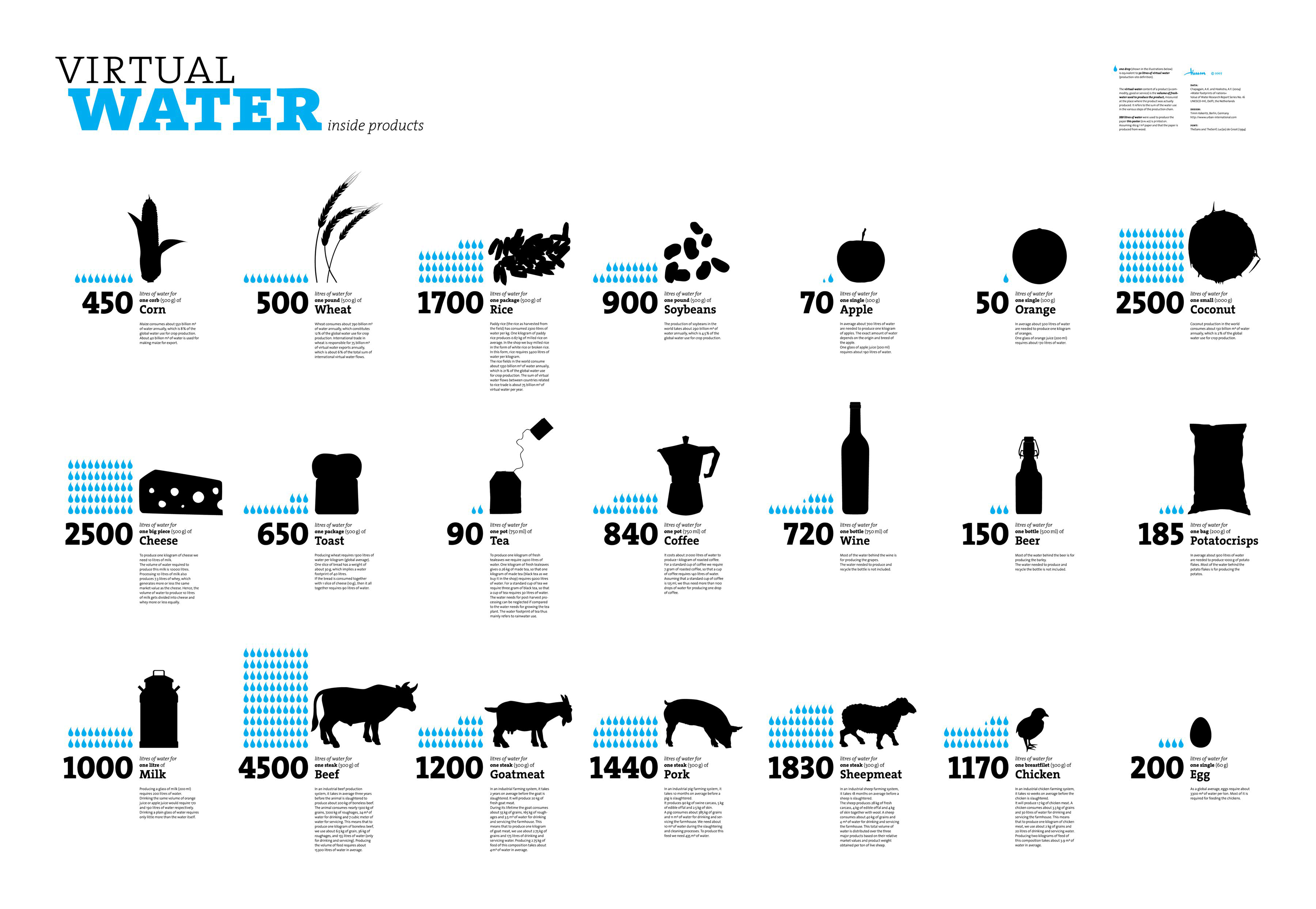Water is a vital component of our planet, and it is essential for the survival of all living things. However, it is not just the physical water that we can see and touch that is important; there is also a concept called “virtual water.” Virtual water refers to the water that is used in the production of goods and services, including the water used in the growing of crops, the production of meat, and the manufacturing of products.
Virtual water is an important concept because it allows us to understand the impact of our daily activities on the planet’s water resources. By understanding how much virtual water is used in the production of the goods and services we consume, we can make informed decisions about our consumption patterns and work to reduce our water footprint. In this article, we will explore what virtual water is, how it is measured, and why it is essential to consider it in our daily lives.
Virtual water is the water used in the production of goods and services. It is the water that is embedded in the production process, and is often invisible to consumers. Virtual water trade is the sum of water used in the production of a good or service exported from one country to another. In essence, it is the water resources used to produce the goods and services that are exported, instead of being used directly by the local population.

What is Virtual Water?
Virtual water is a concept that refers to the amount of water used in the production of goods and services. It is a measure of the water used to produce a specific item, such as food, clothing, or energy. Virtual water can be used to assess the impacts of water scarcity, especially in water-stressed regions of the world.
Understanding Virtual Water
Virtual water is a concept that has been developed to help understand the amount of water embodied in the production of goods and services. It is a measure of the amount of water used in the production, manufacture, and distribution of a product. For example, it can be used to measure the water used to produce a kilogram of potatoes, or to manufacture a car. Virtual water provides a way to assess the impacts of water scarcity, especially in water-stressed regions of the world.
Virtual water can be used to measure the water used in the production of food and other goods. It is expressed as the volume of water used to produce a certain amount of a product. For example, a kilogram of beef requires 15,000 liters of water to produce, while a kilogram of wheat requires 1,300 liters of water. Understanding virtual water can help to identify water-stressed regions and assess the potential impacts of water scarcity.
Uses of Virtual Water
Virtual water can be used to identify water-stressed regions and assess the potential impacts of water scarcity. By understanding the amount of water used in the production and manufacture of different products, it can be used to assess the potential impacts of water scarcity, and to identify water-stressed regions.
Virtual water can also be used to assess the environmental impacts of different products. By understanding the amount of water used in the production of a product, it can be used to assess the environmental impacts of different products. For example, it can be used to assess the impacts of water used in the production of meat, compared to the impacts of water used in the production of plant-based foods.
Impacts of Virtual Water
The concept of virtual water has been used to help assess the potential impacts of water scarcity, and to identify water-stressed regions. It has also been used to assess the environmental impacts of different products, such as the impacts of water used in the production of meat, compared to the impacts of water used in the production of plant-based foods.
In addition, virtual water has been used to assess the potential impacts of global trade on water resources. By understanding the amount of water used in the production of a product, it can be used to assess the potential impacts of global trade on water resources. This can help to identify areas where water resources are being overused, and to identify potential solutions for reducing the impacts of global trade on water resources.
Frequently Asked Questions about Virtual Water
Virtual water is the invisible water used in the production and trade of goods and services. It is the volume of water required to produce goods and services that are traded in global markets.
What is Virtual Water?
Virtual water is the invisible water used in the production and trade of goods and services. It is the volume of water required to produce goods and services that are traded in global markets. The concept of “virtual water” was coined by Professor Tony Allan in 1993 to describe the hidden water embedded in goods and services, and to emphasize the global water trade taking place among nations. This invisible water can account for a large portion of a nation’s water footprints.
For example, the production of 1kg of wheat requires around 1,000 liters of water, the production of 1kg of beef requires around 15,000 liters of water, and the production of 1kg of cotton requires around 10,000 liters of water. Therefore, the water required to produce a product is “invisible” in the product itself, but it affects the water availability of a nation.
How is Virtual Water Trade Measured?
Virtual water trade is measured through the water footprints of a nation. A water footprint is the total volume of freshwater consumed by a nation. It is expressed in cubic meters per person per year. The water footprints of a nation include both the water used domestically and the water used in the production of goods and services that are traded in global markets. The water footprints of a nation include both the water used domestically and the water used in the production of goods and services that are traded in global markets.
For example, countries that export a lot of water-intensive products (e.g., coffee, cotton, and rice) have high virtual water exports, while countries that import a lot of water-intensive products (e.g., wheat and beef) have high virtual water imports. The water footprints of nations can be used to compare the water consumption of different countries and to identify countries that are vulnerable to water scarcity.
What are the Impacts of Virtual Water Trade?
Virtual water trade can be beneficial for some countries, as it allows them to access goods and services that they would otherwise not be able to produce. However, virtual water trade can also lead to water scarcity in some countries. For example, countries that export a lot of water-intensive products (e.g., cotton and rice) may experience water scarcity due to the high demand for water in the production of these products.
The effects of virtual water trade can be seen in the water footprints of different countries. Countries that export a lot of water-intensive products have high virtual water exports, while countries that import a lot of water-intensive products have high virtual water imports. This can lead to water scarcity in some countries, as the demand for water in the production of goods and services outweighs the availability of water in the country.
What are the Solutions to Virtual Water Trade?
There are several solutions to virtual water trade, including increased efficiency and conservation measures, improved water management, and water reuse and recycling. By improving the efficiency of water use, countries can reduce their water footprints and the amount of virtual water being traded. Improved water management can also help reduce the amount of virtual water being traded, as it can help reduce water waste and improve water conservation.
In addition, water reuse and recycling can help reduce the amount of virtual water being traded. By reusing and recycling water, countries can reduce the demand for fresh water, thus reducing the amount of virtual water being traded. This can help ensure that water is used in a more sustainable and efficient manner.
What are the Benefits of Virtual Water Trade?
Virtual water trade can be beneficial for some countries, as it allows them to access goods and services that they would otherwise not be able to produce. This can help reduce poverty and improve the quality of life in some countries. In addition, virtual water trade can help reduce water scarcity in some countries, as it can allow countries to access water-intensive products without having to use their own water resources.
Virtual water trade can also help reduce global trade imbalances. By trading water-intensive products, countries can access products without having to invest in the infrastructure and technology needed to produce them. This can help reduce global trade imbalances and encourage economic development in some countries.

What is Virtual Water?
In conclusion, virtual water is an important concept that we must understand and appreciate in today’s world. It has become a valuable tool in managing global water resources and ensuring food security. Virtual water is not only a measure of the water used in agricultural production, but it also encompasses the entire supply chain of goods and services that we consume. As we consume more products from around the world, we are also consuming more virtual water.
As individuals, we have the power to make a positive impact on the virtual water footprint by making conscious choices about the products we consume. By reducing our consumption of meat and dairy products, and choosing locally grown produce, we can decrease our virtual water footprint and contribute to a more sustainable future. As a society, we must also work together to implement policies and practices that promote responsible water use and sustainable agriculture. By working together, we can ensure that virtual water is used in a way that benefits both people and the planet.



